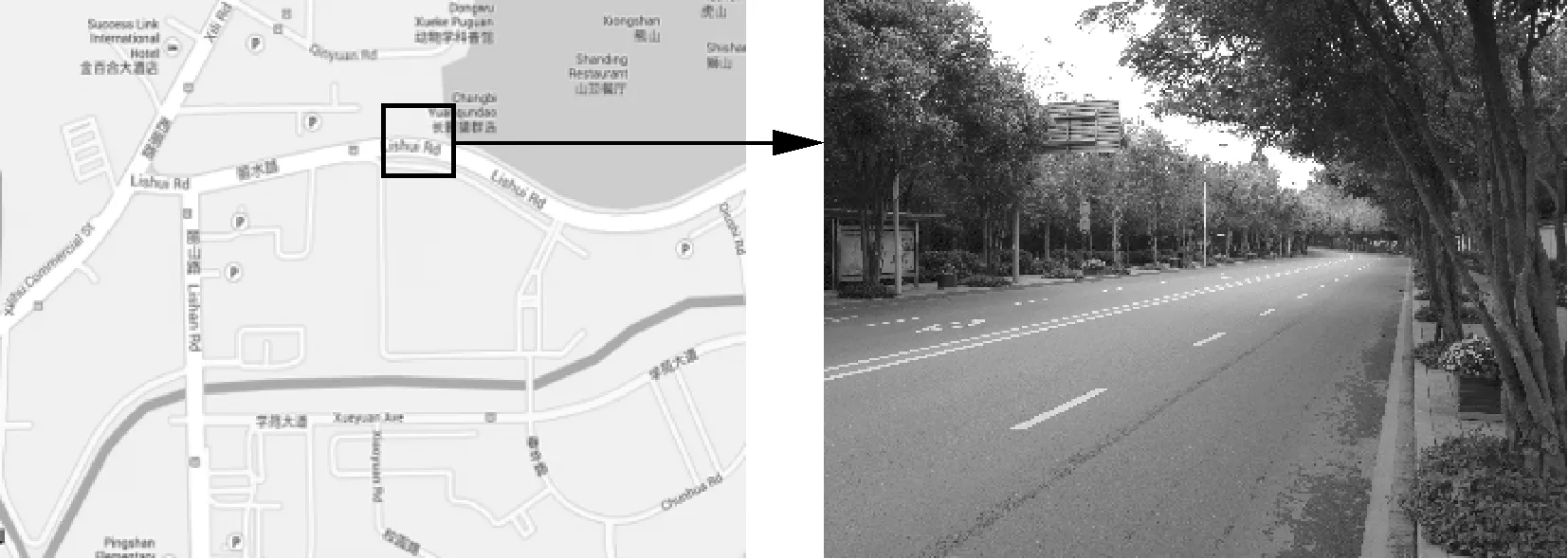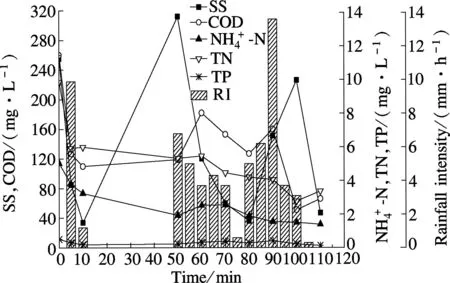Characterizing urban road runoff quality in South China: a case study in Shenzhen
2014-09-06ZhangJianjunJiangYiziLiuAnGuanYuntaoYeShaohua
Zhang Jianjun Jiang Yizi Liu An Guan Yuntao,3 Ye Shaohua
(1Shenzhen Municipal Design & Research Institute Co., Ltd., Shenzhen 518029, China)(2Graduate School at Shenzhen, Tsinghua University, Shenzhen 518055, China)(3State Environmental Protection Key Laboratory of Microorganism Application and Risk Control, Tsinghua University, Beijing 100084, China)
Characterizing urban road runoff quality in South China: a case study in Shenzhen
Zhang Jianjun1Jiang Yizi2Liu An2Guan Yuntao2,3Ye Shaohua1
(1Shenzhen Municipal Design & Research Institute Co., Ltd., Shenzhen 518029, China)(2Graduate School at Shenzhen, Tsinghua University, Shenzhen 518055, China)(3State Environmental Protection Key Laboratory of Microorganism Application and Risk Control, Tsinghua University, Beijing 100084, China)
In order to have an in-depth understanding of road runoff characteristics and the linkages to their influential factors, this paper investigates the road runoff quality in a city of South China, Shenzhen. Four rainfall events with different characteristics are monitored on a typical urban road. It is noted that the road runoff quality is worse than Grade Ⅳ of environmental quality standards for surface water. This means that the road runoff has posed a serious risk to water environment health. Furthermore, the research outcomes indicate that first flush highly varies with rainfall patterns and pollutant species. This means that for road runoff treatment design, rainfall patterns as well as pollutant species should be taken into consideration and this is particularly essential to design first flush capturing devices. Additionally, the threshold of an initial 3 to 5 mm rainfall depth is suggested to the first flush capturing device design. These results provide useful suggestions to the effective road runoff treatment design.
stormwater pollution; road runoff quality characteristics; first flush; low impact development (LID)
Road runoff has received much attention in the area of urban stormwater pollution control[1-2]. Urban road surfaces are a major pathway to produce stormwater pollutants due to traffic activities and its nature of impervious surfaces[3]. In order to mitigate the urban road runoff pollution, structural strategies such as low impact development (LID) have been used in many cities. Unfortunately, the current stormwater treatment system is far from effective on the treatment capacity. This is due to lack of knowledge on the urban road runoff characteristics which are easily influenced by the surrounding environment, such as rainfall characteristics and land use. This highlights the need to have an in-depth understanding of road runoff quality characteristics. This paper investigates the road runoff characteristics in a city of South China, Shenzhen. The developed knowledge is expected to provide a useful insight to stormwater treatment design.
1 Materials and Methods
1.1 Study site
The selected sampling site is a typical urban road with asphalt pavement in Shenzhen city. It is a four-lane two-way road with a mean traffic volume of 750 veh/h. Educational and residential areas are the primary land use types in the sampling site. The urban road runoff samples are collected in a drainage gully with a drainage area of 320 m2on the road (see Fig.1).

Fig.1 The sampling site
1.2 Sampling and laboratory testing
The runoff samples were collected from four rainfall events with different rainfall characteristics as shown in Tab.1. The rainfall events which were greater than 10 mm/h of average rainfall intensity were considered as “large events” while the remaining events were “small events”. The sampling procedure was undertaken at intervals of 5 min in the first 30 min of each runoff event, followed by the 10-minute interval between 30 and 60 min and then the 30 min after 60 min.


Tab.1 The rainfall characteristics
Notes: ARI represents the average rainfall intensity; RD represents the rainfall duration; ADD represents the antecedent dry days; RT represents the rain types.
1.3 Determination of runoff volume and quality parameters
1.3.1 Pollutant event mean concentration
Event mean concentrations (EMC) rather than instantaneous concentrations are used to initially compare the runoff quality of rainfall events in the study. This is due to the fact that the EMC represents the average pollutants amount for a rainfall event and hence can be considered as an event characterization in terms of stormwater quality[6]while instantaneous concentrations have a relatively high variation with time. Furthermore, this is also supported by the fact that EMC is the parameter adopted to estimate the pollutants load, which is typically used in stormwater quality treatment design[7-8]. The EMC can be expressed as
(1)
whereMis the total mass of pollutant over an entire event duration, g;Vis the total volume of flow over an entire event duration, m3;tis the time, min;Ctis the time variable concentration, mg/L;qtis the time variable flow, m3/min; and Δtis the discrete time interval, min. In this study, the rainfall volume is seen asqt.
1.3.2 Dimensionless cumulative mass vs. volume curves
The mass-based first flush can be indicated by the dimensionless cumulative mass vs. volume curves (LV curve). In the mass-based first flush, the pollutant load washed-off during the storm event is evaluated. As the first flush is typically defined as the wash-off of a relatively higher pollutant load during the early part of the runoff event, the comprehensive analysis of the variation of cumulative pollutant loadLvs. cumulative runoff volumeVis important to understand the first flush characteristics. The calculations of the first flush are as follows:
(2)
(3)
whereMtris the dimensionless cumulative mass transported during any measured interval;M(tr) is the cumulative mass transported during any measured interval, kg;Mtis the total mass transported throughout the duration at each event, kg;Cis the pollutant concentration during any measured interval, mg/L;qis the flow rate during any observed interval;tris the any time between the initial of runoff and the time coinciding with the cessation of runoff, min; Δtand Δtrare the time increments between successive measurements, min.Qtris the dimensionless cumulative flow rate during any observed interval;Q(tr) is the cumulative flow rate during any measured interval, m3/min; andQtis the total flow rate observed throughout the duration in each event, m3/min.
The first flush is observed when the data ascended above the 45° line. The 45° line represents the case when the pollutant loads remain constant throughout the storm runoff. Conversely, dilution is assumed to have occurred when the data fell below the 45° line[9-10]. The deviation of the cumulative pollutant mass curve from the diagonal is used as a measure of the magnitudes of the first flush.
1.3.3 Pollution loads transported by stormwater runoff
To understand the dynamics of the first flush, a calculable definition of the first flush must be chosen. Saget et al.[11]defined the first flush as the percentage of total event pollution load transported by the first 30% of the stormwater runoff volume (FF30). There are three categories of the first flush[12], the high first flush(FF30≥50%), the medium first flush(30% 2.1 Comparison of runoff quality Furthermore, it can be observed that EMCs from these four rainfall events show relatively high relative standard deviation (RSD) values (>35%) regardless of pollutant species. This confirms that the high variability of road runoff quality with different rainfall characteristics as a data set with RSD greater than 10% is considered as having a high variability[14]. Tab.2 Stormwater runoff quality of four rainfall events mg/L Note: Grade Ⅳ means Grade Ⅳ of environmental quality standards for surface water (GB3838—2002). 2.2 Variability of runoff quality Fig.2 shows the variability of pollutant concentrations with time. It is noted that the trends of pollutant concentrations with time are different among the four rainfall events. The pollutant concentrations in Event Ⅰ and Ⅲ are higher in the initial 10 min than the corresponding values in the remaining portion of rainfall events, which levels off at a certain value. However, the pollutant concentrations in Events Ⅱ and Ⅳ show a relatively higher variation with time throughout the entire rainfall events. For example, the pollutant concentrations at the 40th min in Event Ⅳ are much higher than others. This can be attributed to different rainfall patterns. It is found that Events Ⅰ, Ⅲ and Ⅳ have the high rainfall intensity(RI) in the initial portion of the hyetographs while Event Ⅱ shows the high intensity in both initial and later parts. Therefore, these observations imply that the rainfall pattern could be an important influential factor to affect road runoff quality characteristics. The events with high rainfall intensity occurring in the initial portion can lead to high pollutant concentrations at the beginning of runoff, namely higher magnitude of the first flush. Additionally, it is also noteworthy that different pollutant species show different runoff characteristics although they experienced the same rainfall event. For example, SS and COD in Event Ⅰ show much higher concentrations in the early runoff portion than the other three pollutants. The trends of exportation for pollutants are also different even in the same rainfall event. This means that the road runoff quality characteristics also vary highly with pollutant species. Fig.3 shows the LV curve of the four events. It is noted that the magnitude of the first flush in Event Ⅰ is relatively high compared with the other three events since there are bigger gaps between the LV curve and the 45° line in Event Ⅰ (see Fig.3). This can be attributed to different rainfall characteristics since Alias[15]has pointed out that the rainfall characteristics are one of the key influential factors in affecting the first flush. Additionally,it is also noteworthy that the first flush of different pollutants appears differently even in the same rainfall event. For example, in terms of Event Ⅰ, SS and COD represent the higher magnitudes of the first flush while TN is the lowest. (a) (b) (c) (d) (a) (b) (c) (d) This could be due to their natures of solubility since nitrogen is primarily present in the dissolved form. However, the first flush phenomenon is more complex in Event Ⅱ while there is no first flush occurrence in Event Ⅳ. This further confirms the conclusions that the first flush can vary highly with rainfall characteristics as well as the pollutant species. This means that for road runoff treatment design, the rainfall pattern as well as the pollutant species should be taken into consideration and this is particularly essential to design first flush capturing devices. 2.3 Pollution loads transported by stormwater runoff Adequately sizing the stormwater treatment system is important in the design process due to the cost-effectiveness. In the case of the design volume being too small, a large number of rainfall events will exceed the capacity of the treatment device. Alternately, if the design volume is too large, there will be increased cost as well as further treatment being negligible after a certain threshold[16]. This highlights the need to determine a threshold of the runoff volume which can carry an appropriate portion of pollutant loads. This is undertaken by investigating the pollutant loads transported by the runoff. This paper shows that the road runoff quality is worse than Grade Ⅳ of environmental quality standards for surface water in Shenzhen. This means that the road runoff has posed a serious risk to water environment health. Furthermore, the research outcomes indicate that the first flush varies highly with the rainfall pattern and pollutant species. This means that for road runoff treatment design, the rainfall pattern as well as pollutant species should be taken into consideration and this is particularly essential to design first flush capturing devices. Additionally, a threshold, the first 3 to 5 mm rainfall depth, is suggested as the first flush capturing device design. These results provide a useful insight to the effective road runoff treatment design. Tab. % [1]Mahbub P, Goonetilleke A, Ayoko G A, et al. Analysis of build-up of heavy metals and volatile organics on urban roads in gold coast, Australia [J].WaterScienceandTechnology, 2011, 63(9): 2077-2085. [2]Brigitte H, Rita H, Alexander S, et al. Runoff pollutants of a highly trafficked urban road — correlation analysis and seasonal influences [J].Chemosphere, 2010, 80(9): 991-997. [3]Liu A, Goonetilleke A, Egodawatta P. Inherent errors in pollutant build-up estimation in considering urban land use as a lumped parameter [J].JournalofEnvironmentalQuality, 2012, 41(5):1690-1694. [4]Lee J Y, Kim H J, Kim Y J, et al. Characteristics of the event mean concentration(EMC) from rainfall runoff on an urban highway [J].EnvironmentalPollution, 2011, 159(4):884-888. [5]Wei F S, Qi W Q, Bi T, et al.Waterandwastewatermonitoringanalysismethod.[M]. 4th ed. Beijing: China Environmental Science Press, 2002: 105-107;210-220;243-284. (in Chinese) [6]Adams B J, Papa F.Urbanstormwatermanagementplanningwithanalyticalprobabilisticmodels[M]. New York: John Wiley & Sons, 2000. [7]Weiss P T, Gulliver J S, Erickson A J. Cost and pollutant removal of stormwater treatment practices [J].JournalofWaterResourcesPlanningandManagement, 2007,133(3):218-229. [8]Taewon K, Kyungik G. Determination of the removal efficiency of a vortex-type facility as a best management practice using the dynamic event mean concentration: a case study of a bridge in Yong-In city in Korea [J].EnvironmentalEarthSciences, 2012, 65(3):937-944. [9]Barco J, Papiri S, Stenstrom M K. First flush in a combined sewer system [J].Chemosphere, 2008, 71(5):827-833. [10]Kim G, Yur J, Kim J. Diffuse pollution loading from urban stormwater runoff in Daejeon city, Korea [J].JournalofEnvironmentalManagement, 2007, 85(1): 9-16. [11]Saget A, Chebbo J, Bertrand-Krajewski J. The first flush in sewer system [J].WaterScienceandTechnology, 1996, 33(9):101-108. [12]Kim L H, Kayhanian M, Zoh K D, et al. Modeling of highway stormwater runoff [J].TheScienceoftheTotalEnvironment, 2005, 293(1/2/3):163-175. [13]Ma Y, Ma Y W, Wan J Q, et al. Characterization of rainfall runoff pollution transportation in different underlying surface of Dongguan City [J].ChinaEnvironmentalScience, 2011, 31(12):1983-1990. (in Chinese) [14]Hamburg M.Statisticalanalysisfordecisionmaking[M]. Philadelphia: The Dryden Press, Harcourt Brace College Publishers, 1994. [15]Alias N. First flush behavior in urban residential catchments [D]. Brisbane, Queensland, Australia: Queensland University of Technology, 2013. [16]Guo J C Y, Urbonas B, MacKenzie K. Water quality capture volume for storm water BMP and LID designs [J].JournalofHydrologicEngineering, 2014, 19(4):682-686. 华南地区城市道路径流污染特性:以深圳市为例 张健君1蒋沂孜2刘 安2管运涛2,3叶少华1 (1深圳市市政设计研究院有限公司, 深圳 518029)(2清华大学深圳研究生院, 深圳 518055)(3清华大学国家环境保护环境微生物利用与安全控制重点实验室, 北京100084) 为了解析华南地区道路径流污染特性及其影响因素,对华南地区典型城市深圳市道路进行了4场降雨的径流样品采集及分析.结果显示道路径流水质劣于地表水4类环境质量标准,说明道路径流已经成为影响城市水环境质量的重要威胁.同时研究发现初期冲刷效应受到降雨类型和污染物种类的双重影响,因此在针对道路径流处理设施特别是初雨截流装置的设计时,需要同时考虑降雨类型与污染物种类.另外,建议华南地区的初雨截流量为3~5 mm的初期降雨.这些研究结果能为有效的道路径流处理设施设计提供有用的建议. 暴雨污染; 道路径流污染特性; 初期冲刷; 低影响开发 X501 s:The National Science and Technology Major Project of China (No.2012ZX07301-001), the Shenzhen Environmental Research Project, China Postdoctoral Science Foundation (No.2013M530642). :Zhang Jianjun, Jiang Yizi, Liu An, et al. Characterizing urban road runoff quality in South China: a case study in Shenzhen.[J].Journal of Southeast University (English Edition),2014,30(2):181-185. 10.3969/j.issn.1003-7985.2014.02.008 10.3969/j.issn.1003-7985.2014.02.008 Received 2013-09-05. Biographies:Zhang Jianjun (1970—), male, senior engineer, zhangjj@ szmedi. com. cn; Guan Yuntao (corresponding author), male, professor, guanyt@ tsinghua.edu.cn.2 Results and Discussion











3 Conclusion

猜你喜欢
杂志排行
Journal of Southeast University(English Edition)的其它文章
- Prediction on effectiveness of road sweepingfor highway runoff pollution control
- A preliminary sustainability assessment of innovativerainwater harvesting for residential properties in the UK
- Approach to estimating non-point pollutant load removal rates based on water environmental capacity: a case study in Shenzhen
- Potential contributions to Beijing’s water supply from reuse of storm- and greywater
- Characteristics of Hg pollution in urban stormwater runoff in Nanjing city, China
- Rainwater harvesting in the challenge of droughts and climate change in semi-arid Brazil
